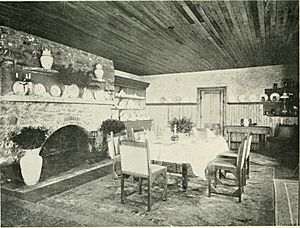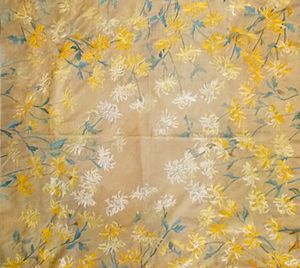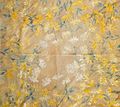Candace Wheeler facts for kids
Quick facts for kids
Candace Wheeler
|
|
|---|---|
 |
|
| Born |
Candace Thurber
March 27, 1827 |
| Died | August 5, 1923 (aged 96) |
| Education | Delaware Academy |
| Occupation | Interior decorator |
| Spouse(s) | Thomas Mason Wheeler |
| Children | 4, including Dora Wheeler Keith |
| Parent(s) | Abner Gilman Thurber Lucy Dunham |
| Relatives | Henry L. Stimson (grandson) |
Candace Wheeler (born Candace Thurber; March 24, 1827 – August 5, 1923) was a very important American designer. Many people call her the "mother" of interior design. She was one of the first women in America to become an interior and textile designer.
Candace Wheeler helped open up the field of interior design for women. She also supported other craftswomen. She encouraged a new style of American design. She started two important groups: the Society of Decorative Art in New York City (1877) and the New York Exchange for Women's Work (1878).
Throughout her long career, Wheeler was known for her work in the Colonial Revival, Aesthetic Movement, and the Arts and Crafts Movement. She was seen as a national expert on home decoration. She also designed the inside of the Women's Building at the 1893 World's Columbian Exposition in Chicago.
Contents
Early Life and Family
Candace Thurber was born on March 24, 1827, in Delhi, New York. This town is west of the Catskill Mountains. Her parents were Abner Gilman Thurber and Lucy Dunham Thurber. Candace was the third of eight children in her family.
Candace had a happy childhood. Her father was a strict Presbyterian and also a strong abolitionist. This meant he was against slavery. He made sure his family never used products made by enslaved people. For example, they used homemade maple sugar instead of cane sugar. They also used linen from flax grown on their farm instead of southern cotton. Candace believed their farm was a stop on the Underground Railroad. This was a secret network that helped enslaved people escape to freedom.
Candace went to an "infant school" where she learned to stitch at age six. Around age 11 or 12, she started attending Delaware Academy in Delhi.
Starting a Career in Design
In 1876, Candace Wheeler visited the Philadelphia Centennial Exposition. She was very impressed by a display from the Royal School of Art Needlework. She saw how needlework could be a business run by women, helping them earn money.
Wheeler thought about creating an American version of this school. It would include "all articles of feminine manufacture." She believed this could help educated women who were struggling financially. She later wrote that she was excited about "work for the army of helpless women of N.Y." These were women who were too proud to beg and not trained for other jobs.
Society of Decorative Art in New York
In 1877, Wheeler founded the Society of Decorative Arts in New York. Other important members included Louis Comfort Tiffany and John La Farge. The Society aimed to help women support themselves. They did this through handicrafts like needlework, sewing, and other decorative arts.
The Society especially focused on the many women who needed help after the Civil War. Wheeler asked wealthy New York women to support a shop. This shop would sell high-quality, custom-made goods to earn money. Within three years, the Society had five hundred supporters. Leading artists were hired to teach or judge exhibits. Wheeler also helped start similar societies in other cities across the United States.
New York Exchange for Women's Work
In 1878, Wheeler helped start the New York Exchange for Women's Work. Here, women could sell anything they made at home. This included baked goods and household linens. This group helped even more women because no artistic skills were needed.
The Exchange opened in March 1878. It quickly became successful. In its first year, it paid out almost $14,000 in earnings to women. By 1891, there were at least seventy-two such Exchanges across the country. In 1879, Wheeler left the Society of Decorative Arts.
Tiffany & Wheeler
In 1879, Candace Wheeler and Louis Comfort Tiffany started an interior-decorating company together. It was called Tiffany & Wheeler. This company decorated many important homes and public buildings in the late 1800s. Some of their projects included the Veterans’ Room of the Seventh Regiment Armory and the drawing room of the Cornelius Vanderbilt II house. They also designed the inside of Mark Twain’s house.
The company was also known as Tiffany & Co., Associated Artists. The partners were Louis Comfort Tiffany, Candace Wheeler, William Pringle Mitchell, and Lockwood de Forest.
Associated Artists
In 1883, Wheeler started her own textile company called Associated Artists. Only women worked there. The company made many different textile products, like tapestries and curtains. Associated Artists was famous for its "changeable" silks. These fabrics were woven with two different threads. This made them change color depending on the light.
Wealthy customers could order custom fabrics. For example, Andrew Carnegie ordered a special design for his home. Wheeler also made sure her products were available to many people. She created patterns that could be made by machines. These designs often showed American patterns and local plants. Between 1884 and 1894, Cheney Brothers made over 500 fabrics for Associated Artists. These were sold all over the United States.
Associated Artists had a special tapestry style. It combined loom weaving and tapestry weaving, a technique Wheeler invented. This made the stitches almost invisible. It created a smoother and more beautiful tapestry.
Onteora Artists' Colony
In 1892, Candace Wheeler, her husband, and her brother founded an artist colony. It was in the Catskill Mountains and called Onteora. This colony was a good place for single women who could show their art or writing skills to earn money. Eventually, the colony owned two thousand acres of land.
Chicago World's Columbian Exposition
In 1893, when she was 66 years old, Wheeler received an important request. She was asked to be the interior decorator for the Woman's Building at the Chicago World's Fair. She also organized New York State's applied arts exhibition there.
The Woman's Building was overseen by Bertha Palmer. It was designed by architect Sophia Hayden. Many famous women artists showed their work there, including Wheeler's daughter Dora Wheeler Keith. The building displayed women's fine arts, crafts, and products from all over the world. The grand rotunda of the building listed "golden names of women" who had honored the human race.
Later Life
In her later years, Candace Wheeler spent much of her time writing. She wrote books and articles about decorating and textile arts. She also wrote fiction. Her last book was published in 1921.
Personal Life
In 1843, Candace met Thomas Mason Wheeler in New York City. They married within a year. They had four children together:
- Candace Thurber Wheeler (1845–1876), whose son, Henry L. Stimson, became the U.S. Secretary of State.
- James Cooper Wheeler (1849–1912).
- Dora Wheeler (1856–1940), who also became an artist.
- Dunham Wheeler (1861–1938).
Candace Wheeler passed away on August 5, 1923, at the age of 96.
Images for kids
See also
 In Spanish: Candace Wheeler para niños
In Spanish: Candace Wheeler para niños




